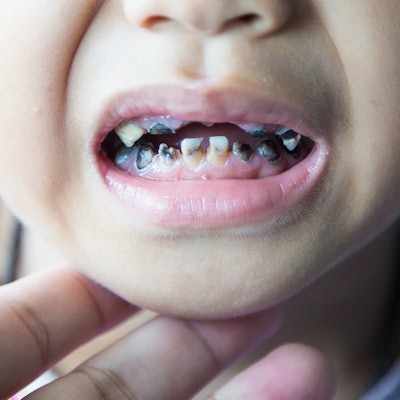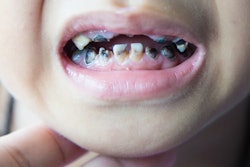
More than 20% of children need restorative treatment by the time of their first dental exam, according to a study published in the Journal of the American Dental Association. The risk of treatment also increases with each year a child waits to see the dentist.
The study encompassed 706,636 privately insured children ages 6 months to 6 years old to shed light on the relationship between the age at first visit and restorative treatment needs. Dentists, medical students, and pediatricians need to be educated on oral health for children to prevent diseases such as early childhood caries (ECC), according to the authors.
"Despite preventive clinical guidelines and recommendations from both the American Dental Association and the American Academy of Pediatric Dentistry, ECC remains the most common, preventable infectious disease among children in the United States, with 21.4% of children aged 2 through 5 years having caries and 8.8% having untreated caries," wrote the group, led by Dr. Sean McGivern, a pediatric dentist who was previously a resident at the University of California, Los Angeles (JADA, September 11, 2021).
Early childhood caries is a common, yet preventable, infectious disease among children. When left untreated, ECC can result in pain and damaged dentition that can interfere with eating, drinking, and sleeping.
Dental organizations promote children undergoing a first dental screening after the eruption of the first tooth, but many parents don't hear that message. With the new study, the researchers aimed to investigate how the age at a patient's first dental exam affects overall needs.
McGivern and colleagues used 2012-2017 claims data from private dental insurers from the IBM MarketScan research databases. They looked at both restorative treatment needs and the use of general anesthesia.
Patients were eligible for inclusion if they had an initial oral health screening, at least one other visit under the age of 6, and at least two continuous years of insurance coverage. Children younger than 6 months were not included because visits were likely related to dental and craniofacial anomalies.
| Risk of need for restorative treatment by age of 1st dental visit | |||
| Age at 1st dental visit | Percentage requiring treatment | Percentage requiring general anesthesia | Hazard ratio vs. kids seen before the age of 1 year |
| 1 | 10% | 10% | 1.0 |
| 2 | 15% | 21% | 1.3 |
| 3 | 21% | 27% | 2.1 |
| 4 | 27% | 23% | 4.0 |
A total of 21% of children included in the study needed restorative treatment after their first dental visit. The average age at the first dental exam was 3.6 years, despite recommendations that children see a dentist before age 1.
The risk of restorative treatment increased with patient age at first dental visit. By the time patients are 3, they have more than double the risk of needing restorative treatment as children seen before the age of 1. At 4 years old, children have quadruple the risk.
General anesthesia was used for 1,200 patients. Those who were older than 3 years at their first exam had a higher likelihood of undergoing restorative treatment under general anesthesia.
General dentists performed 85% of first oral examinations, according to the authors. Pediatric dentists accounted for another 14% of first oral examinations, and physicians performed 1% of exams.
Patients examined by general dentists had more restorative treatment done under general anesthesia than those examined by pediatric dentists or physicians, the authors found. Patients whose first exam was performed by a pediatric dentist had a 16% increased chance of needing restorative treatment compared with those first seen by general dentists.
Based on the findings, the authors concluded that the privately insured patients at the focus of their study are "poorly served according to the current evidence-based recommendations and standards."
McGivern and colleagues called on healthcare providers to actively seek ways to establish dental homes for patients by age 1.
"Investments in educating medical students, pediatricians, and other [primary care providers (PCPs)] about oral health best practices and guidelines for pediatric patients should be pursued," wrote the authors of the report. "At the 6-month well-child visit, all PCPs should be looking for the eruption of the first tooth and making recommendations for seeing a dentist, provide basic oral hygiene instruction and anticipatory guidance, and be able to facilitate scheduling the appointment for the patient."



















